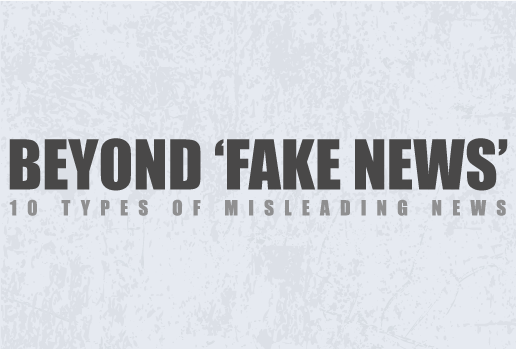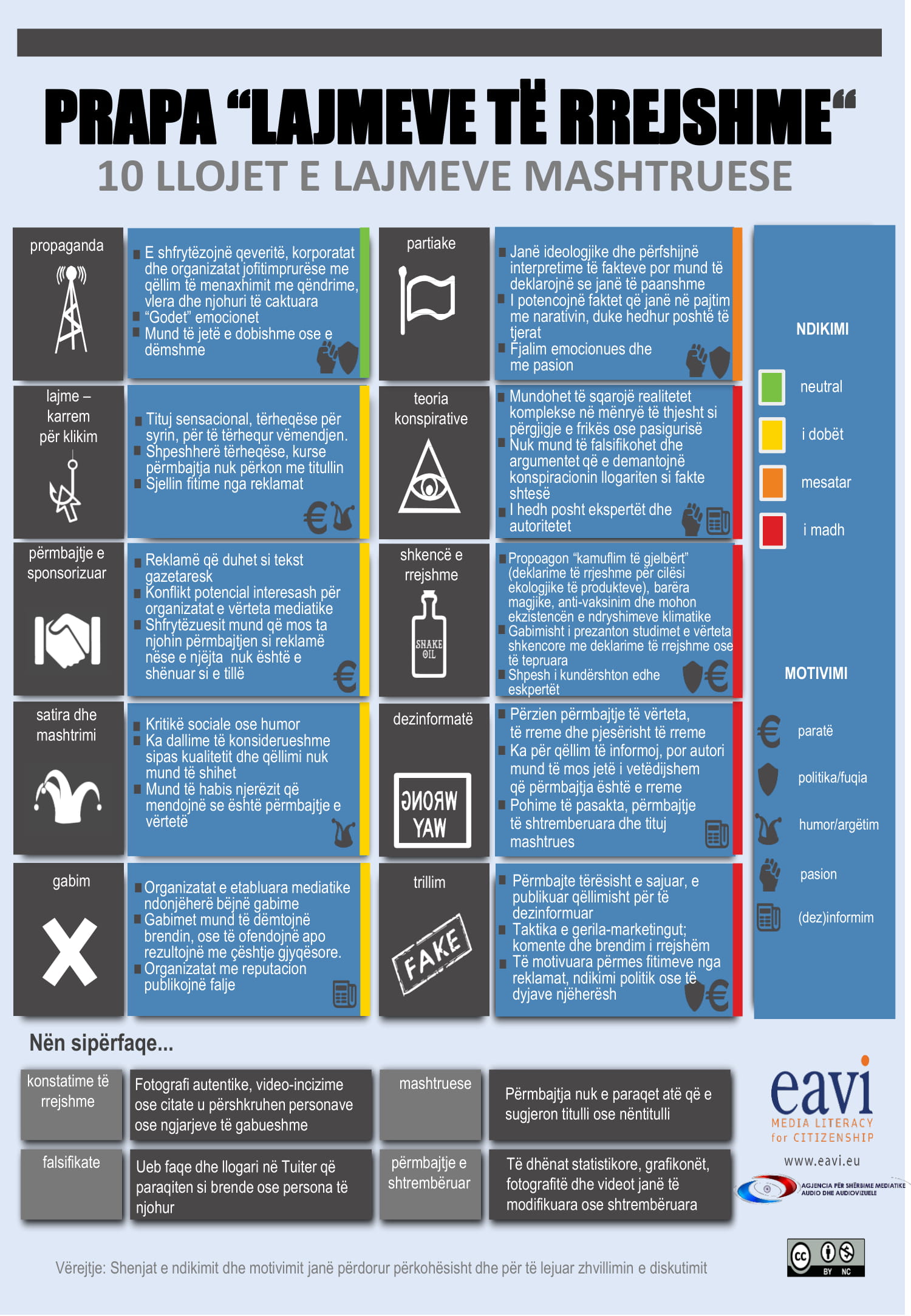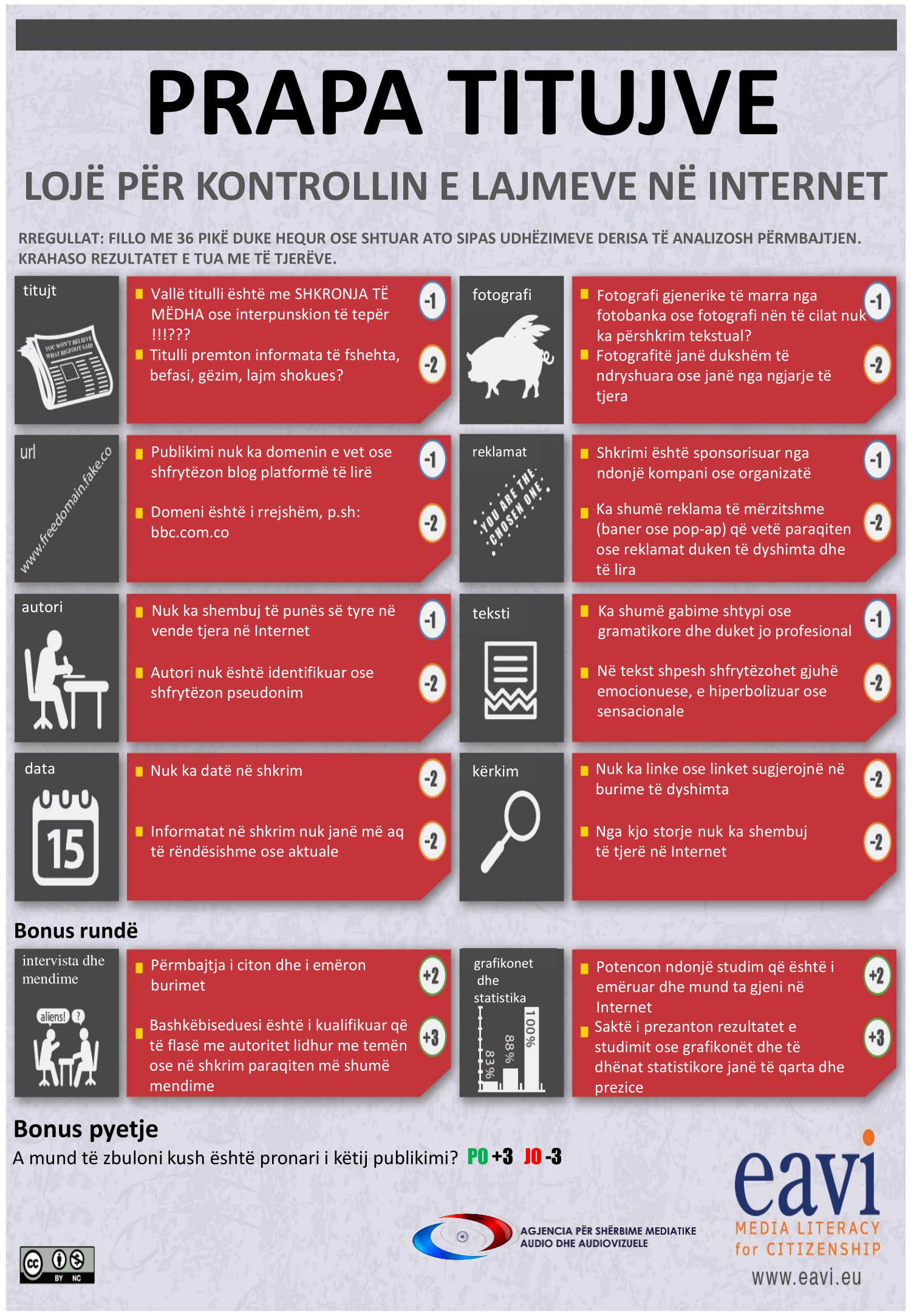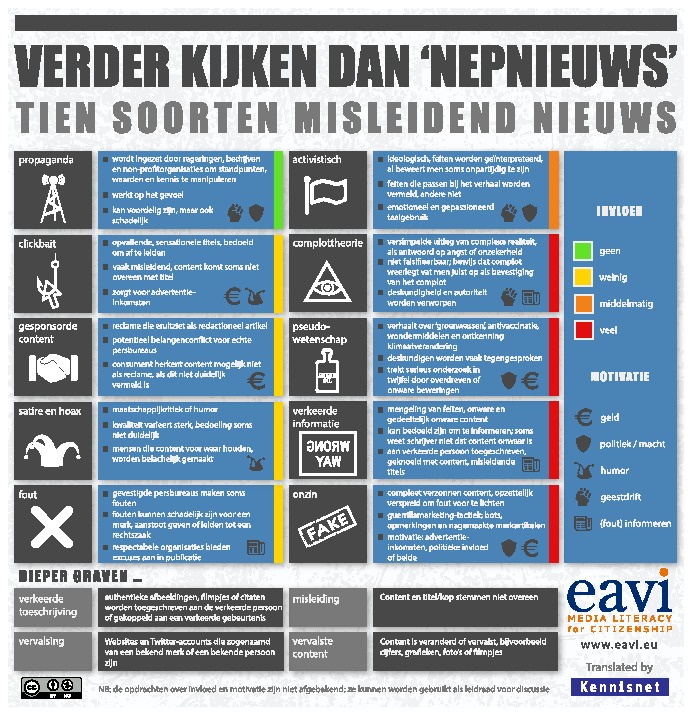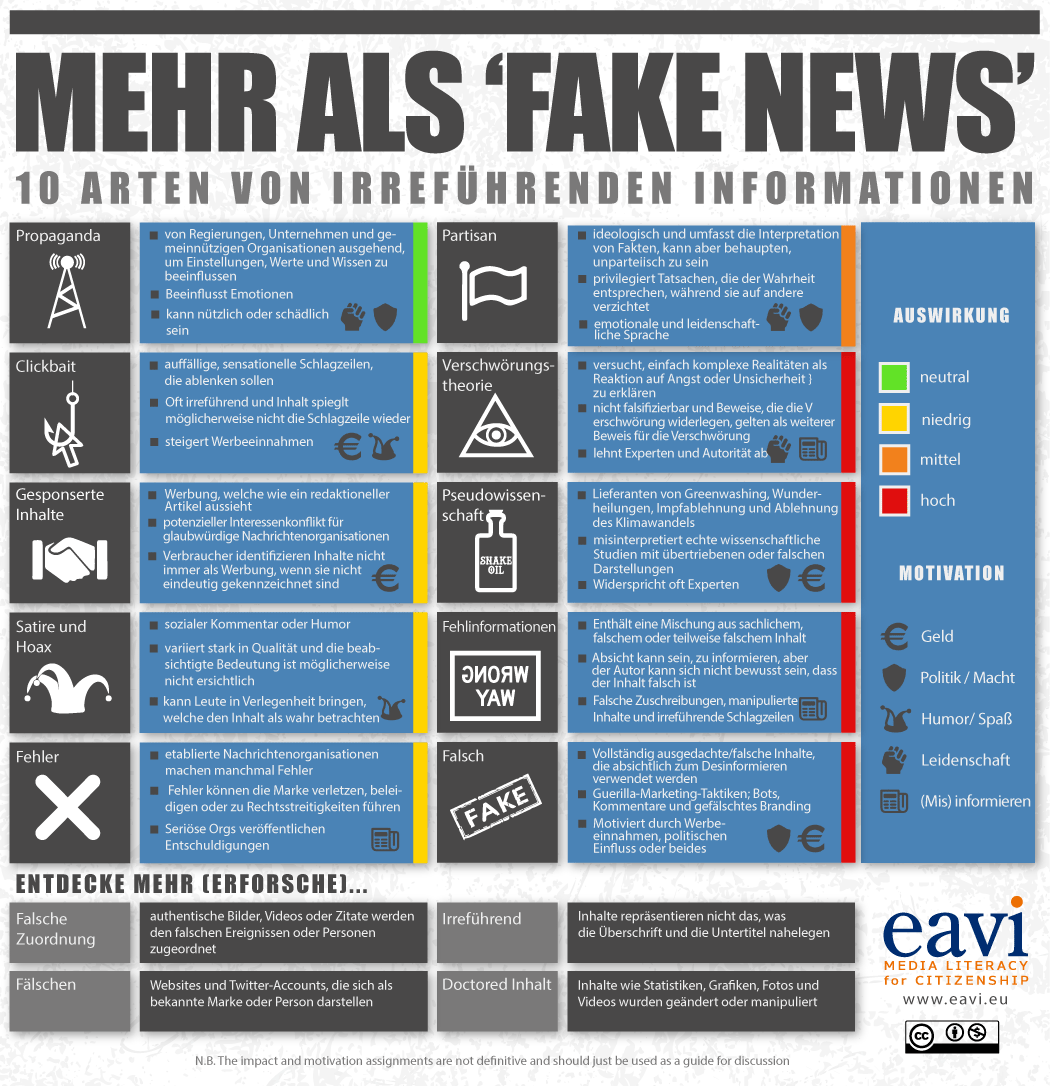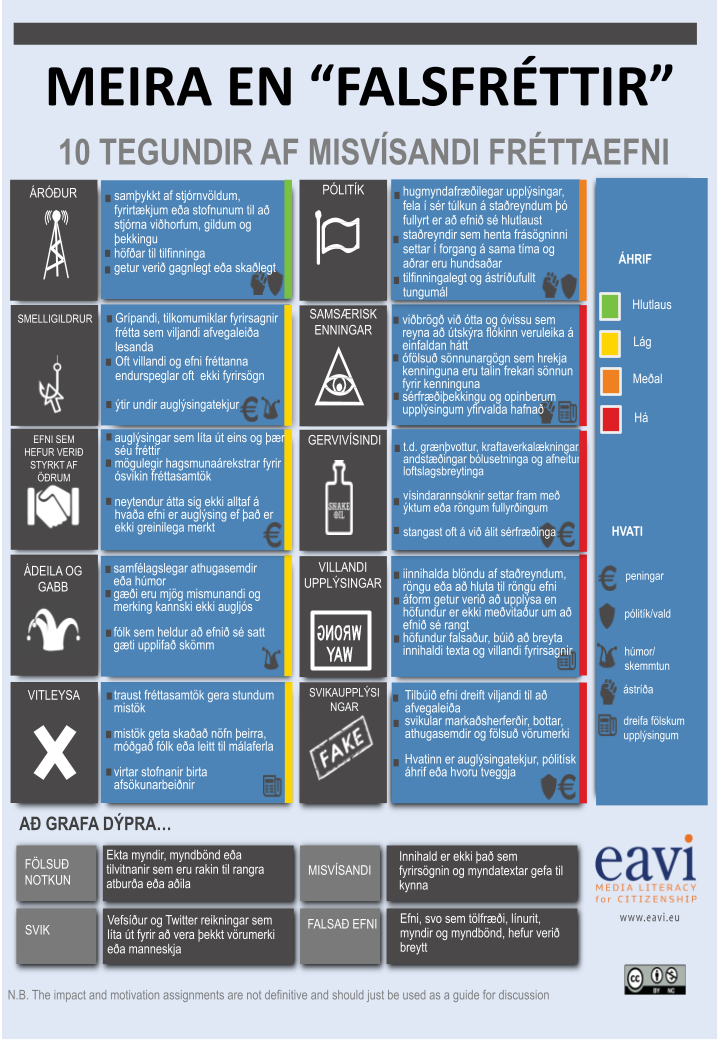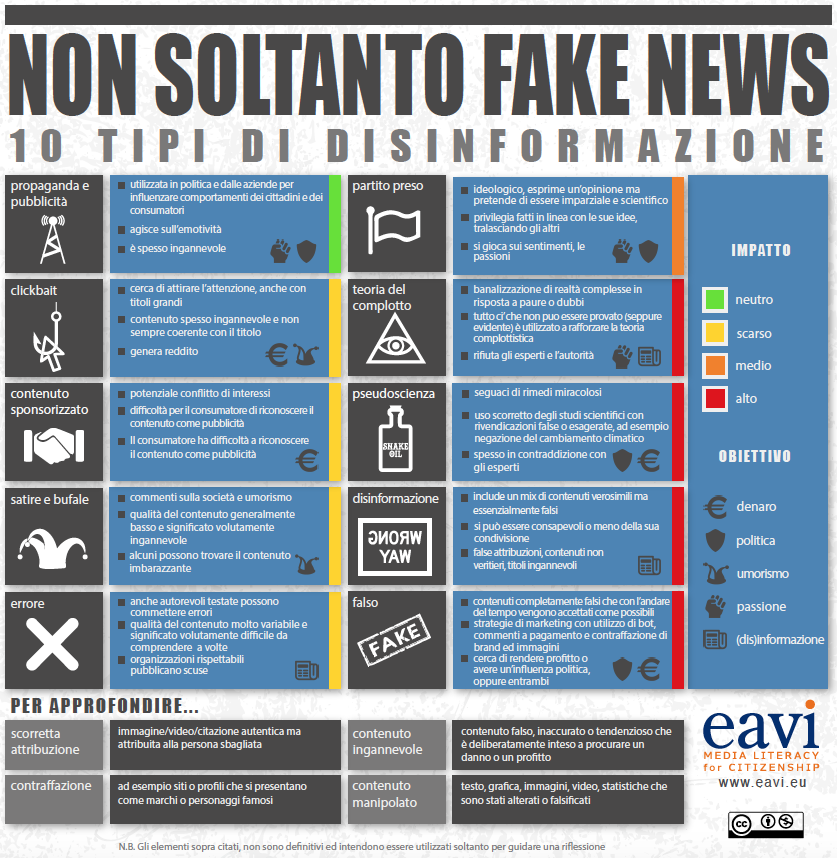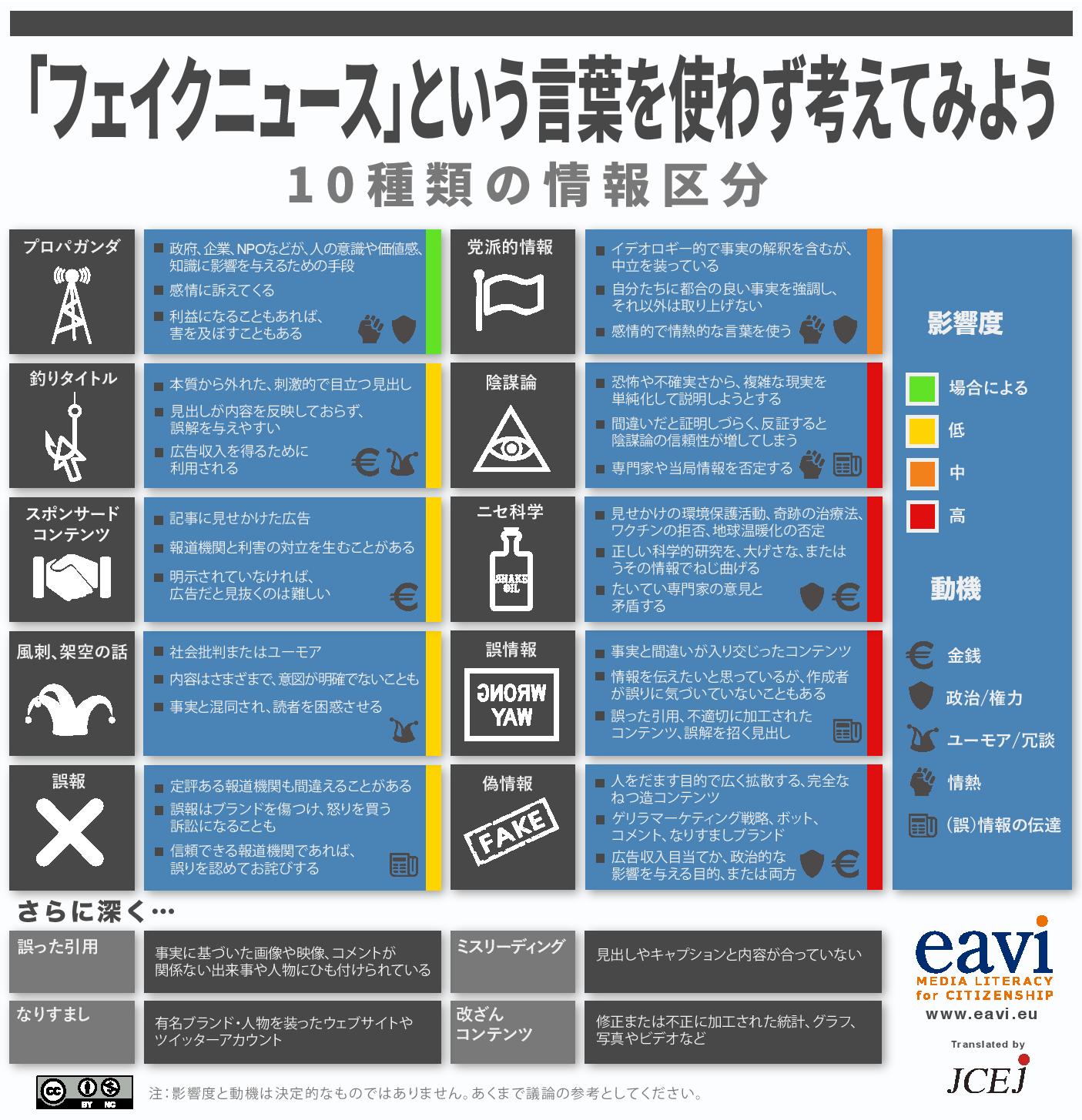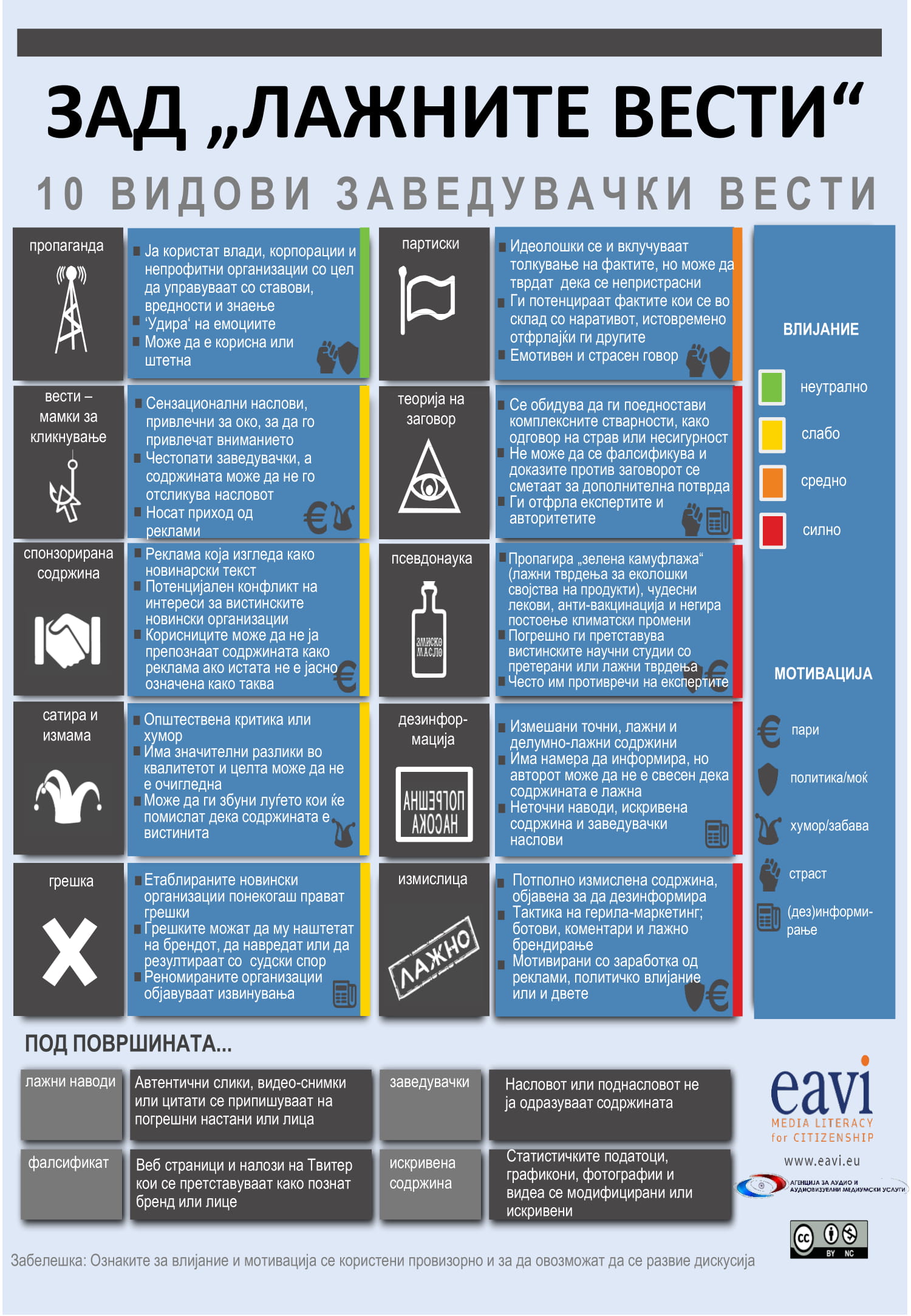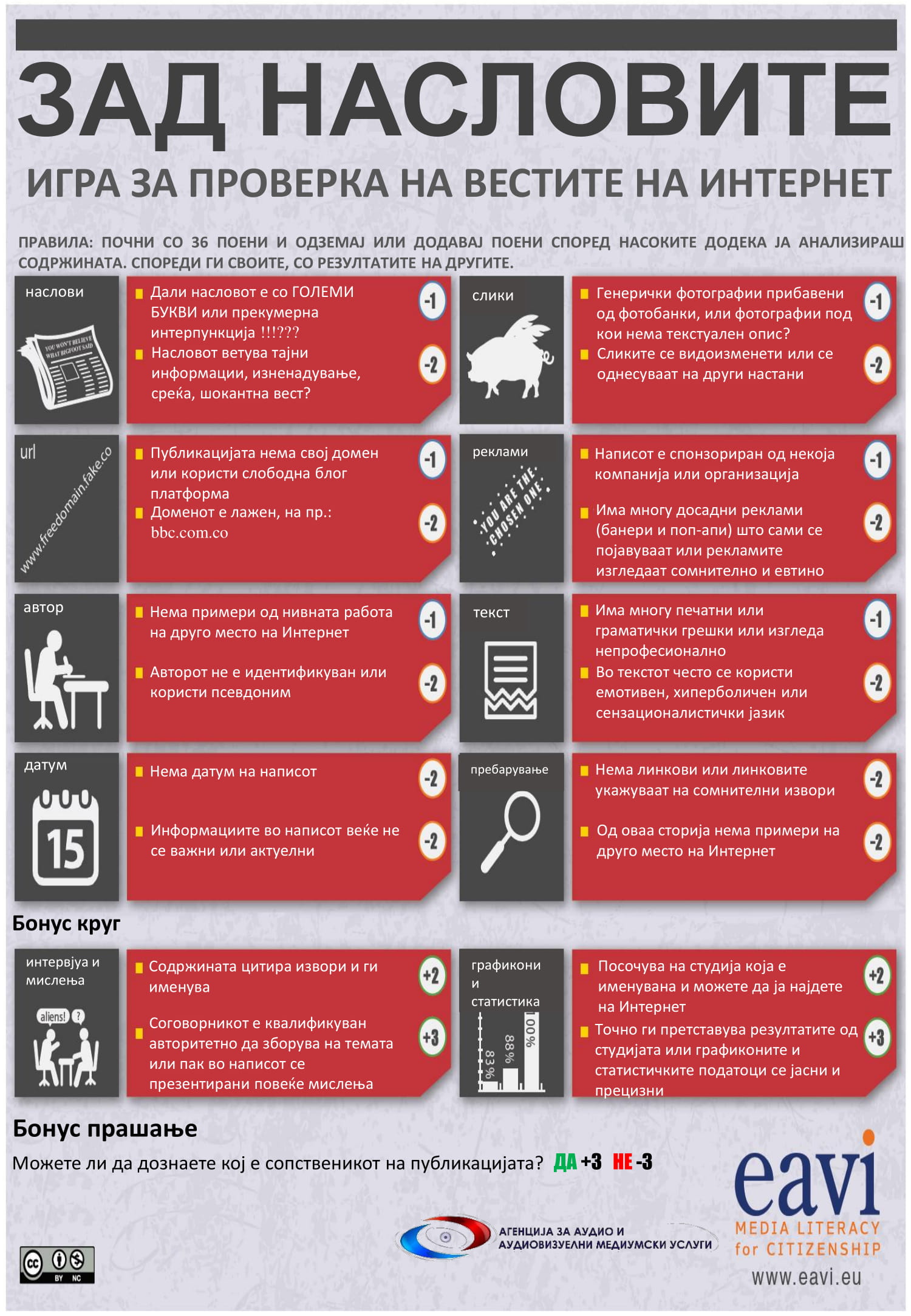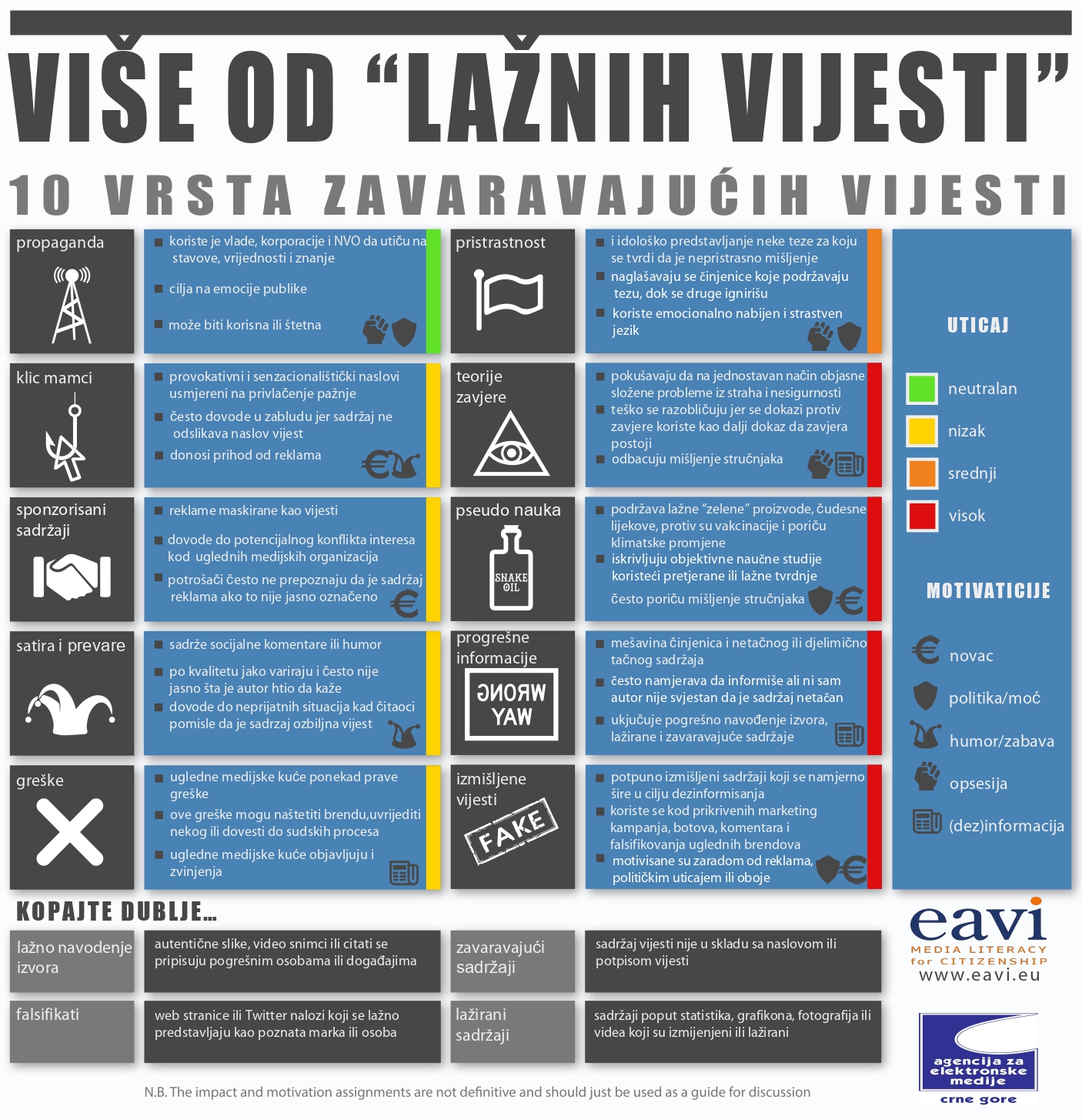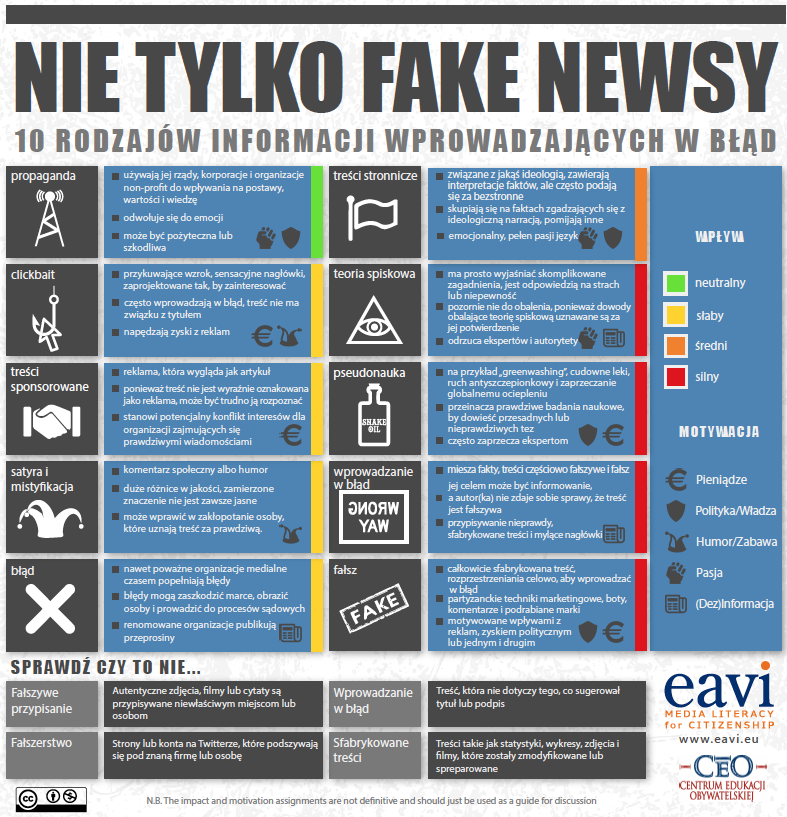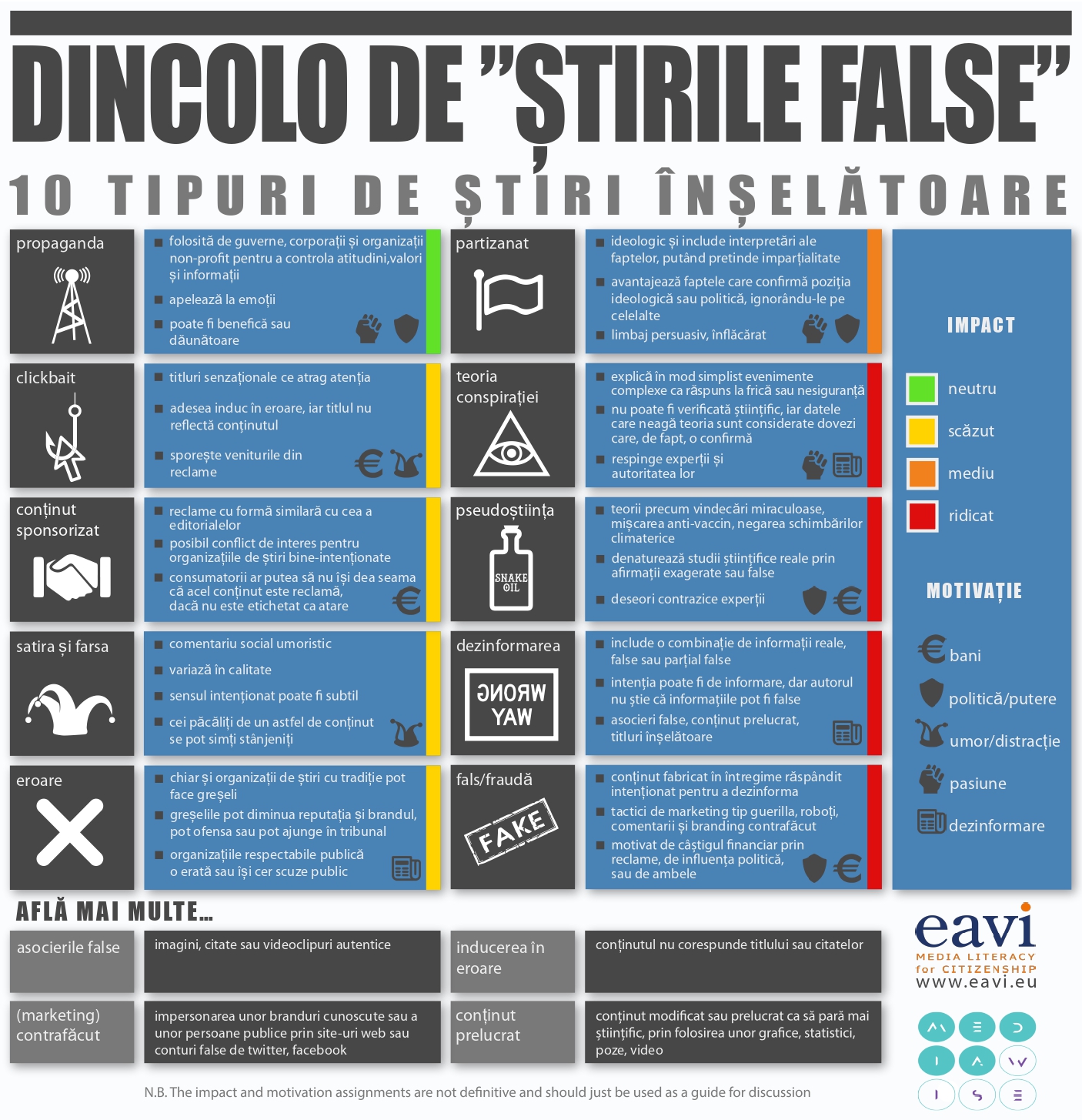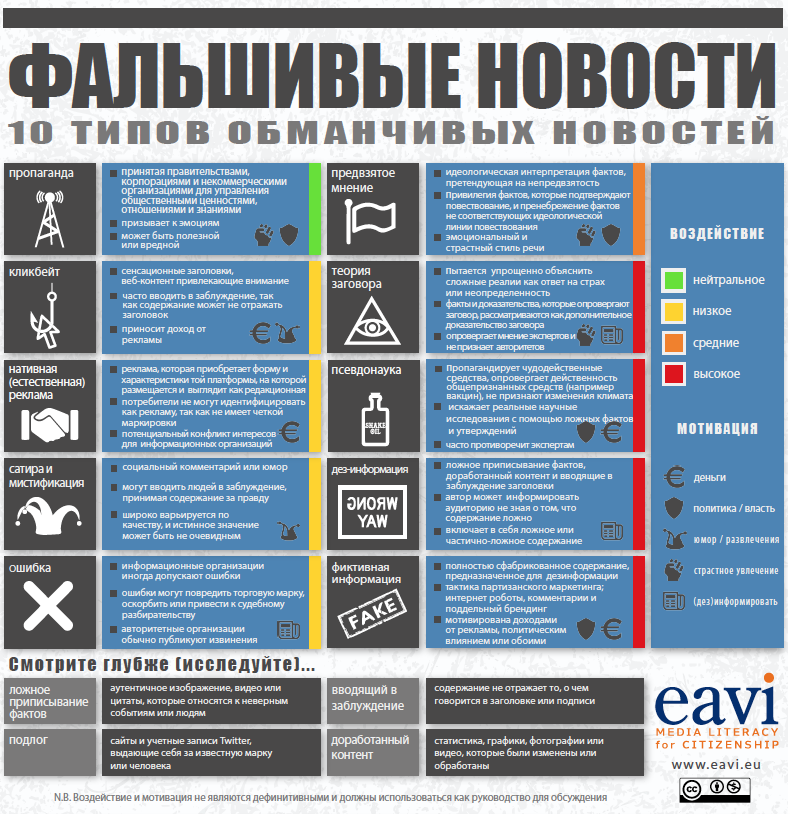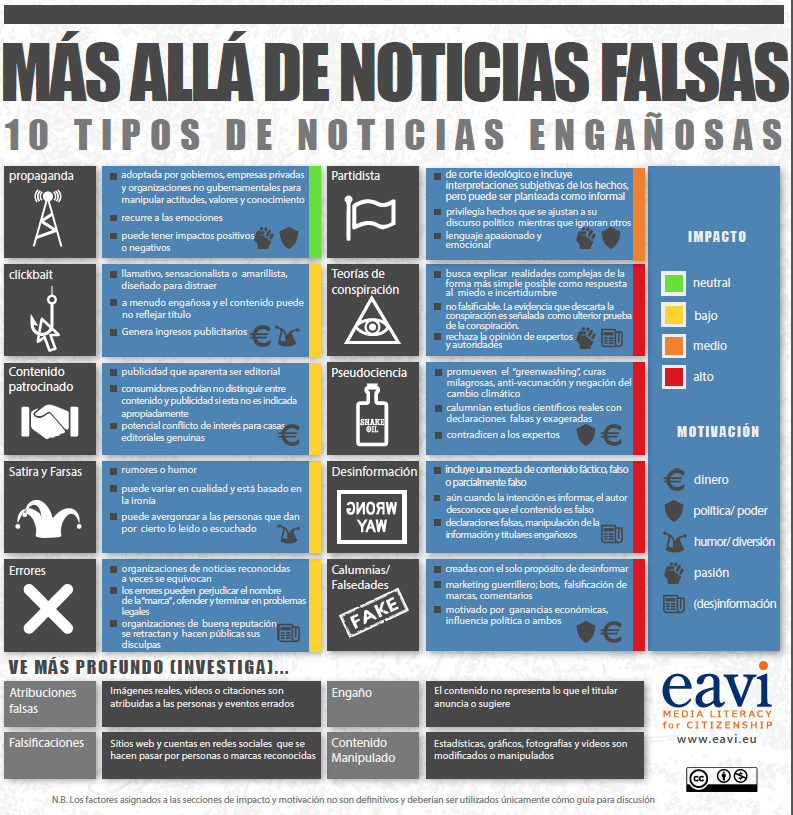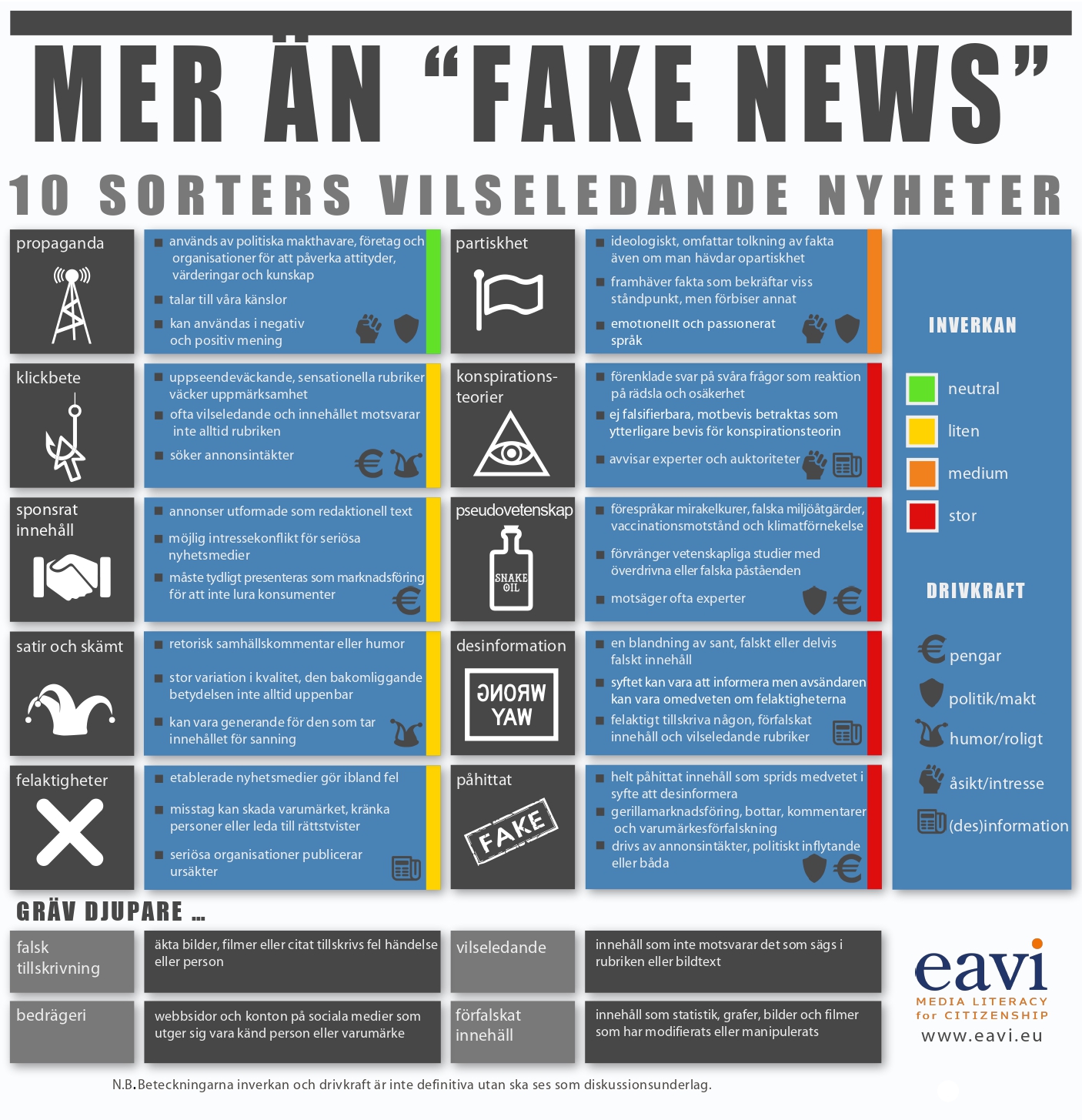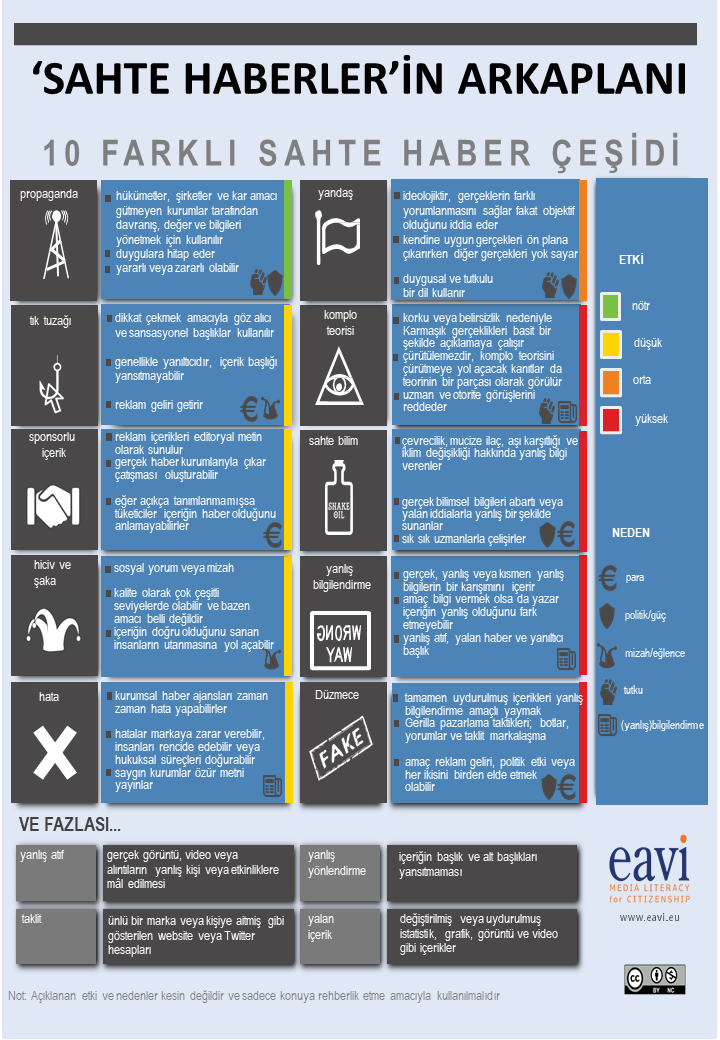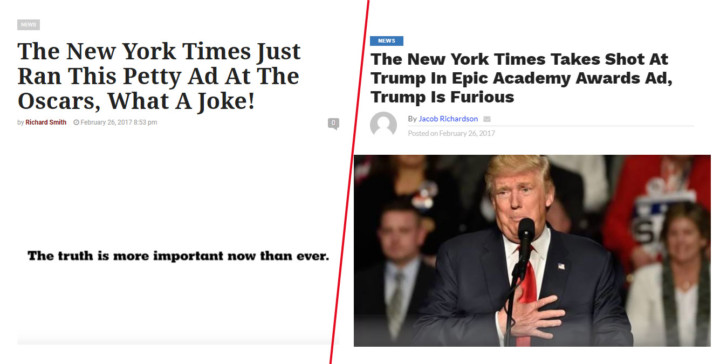The work needed to effectively filter information in our media-saturated environment takes time and skill. A study showed that the more content we consume, the more our ability to make decisions about its veracity becomes impaired. With 80% of Europeans now regularly going online, it is vital for the sustainable and effective functioning of democracy for citizens to be able to curate their media diets with a healthy critical eye.
Our Beyond Fake News infographic identifies the 10 types of potentially misleading news. It was created to be used in class with real-world examples to spark classroom debate and reflection on the ways that media is constructed.
We hesitated to put the term ‘fake news’ in the title of the infographic as, ironically, the term itself is a misleading simplification. Apart from the fact that the term has been co-opted to attack and silence mainstream media, the suggestion that there are simply two types of news; real and fake, doesn’t leave much room for nuance.
Below this article, you will find a pdf version of the infographic as well as a dropdown list containing some resources for teaching the 10 Types of Misleading News.
The 10 types
Of course, neither of the 10 types can be seen in isolation to the others. Partisan news outlets may also be identified as propaganda. And propaganda can be found in a sponsored post. Pseudoscience and conspiracy theories certainly enjoy each others company, see: anti-vaccination movement and climate change denialism. Likewise, completely bogus content may entice its audience with a clickbait headline. Finding examples and identifying which categories they fit into is all part of the fun of using this graphic.
The motivations
The motivations behind certain kinds of content can be many and varied. Money or power are almost always present however, there may be other motivations at play. A pseudoscientific column about climate change may be motivated by a certain ideological or political cause. However, another form of pseudoscience, health news, which some have identified as being among the most prolific in the ‘fake news’ typology, might be motivated by money or share similarities with clickbait characteristics; “The Secret Diet Your Doctor Won’t Tell You About” is a familiar refrain.
Impact levels
The impact levels are not definitive either. For instance, some students may feel that conspiracy theories are just a bit of fun, while some of us reflect that the propagation of one recent conspiracy theory led to an actual incident of violence; Pizzagate.
We hope our infographic will prompt healthy discussion. When used in conjunction with the Center for Media Literacy’s 5 media literacy concepts and questions, we believe it is a powerful way for people of any age to provoke a line of media inquiry that becomes second nature.
Some help, please!
We will endeavour to find resources with which to use and compare with the infographic but we would love it you would suggest your own to us. Especially in languages other than English.
Check out the EAVI Individual Members Group on Facebook and join so you can post examples there.
We would also love to hear your testimonials. Let us know of any successes you have had when using it, or if you think of any ways the graphic can be improved.
Translations
If you are able to translate the infographic into your mother tongue then you are an awesome person! We will credit you, of course. Contact us at [email protected] or reach out to us via our social media channels for more details.
With thanks…
We must also thank EAVI’s individual members for their feedback as well as Katerina Chryssanthopoulou of the newly-formed Media Literacy Institute in Greece for her input and ideas while creating the graphic.
[click the image below for the pdf version]
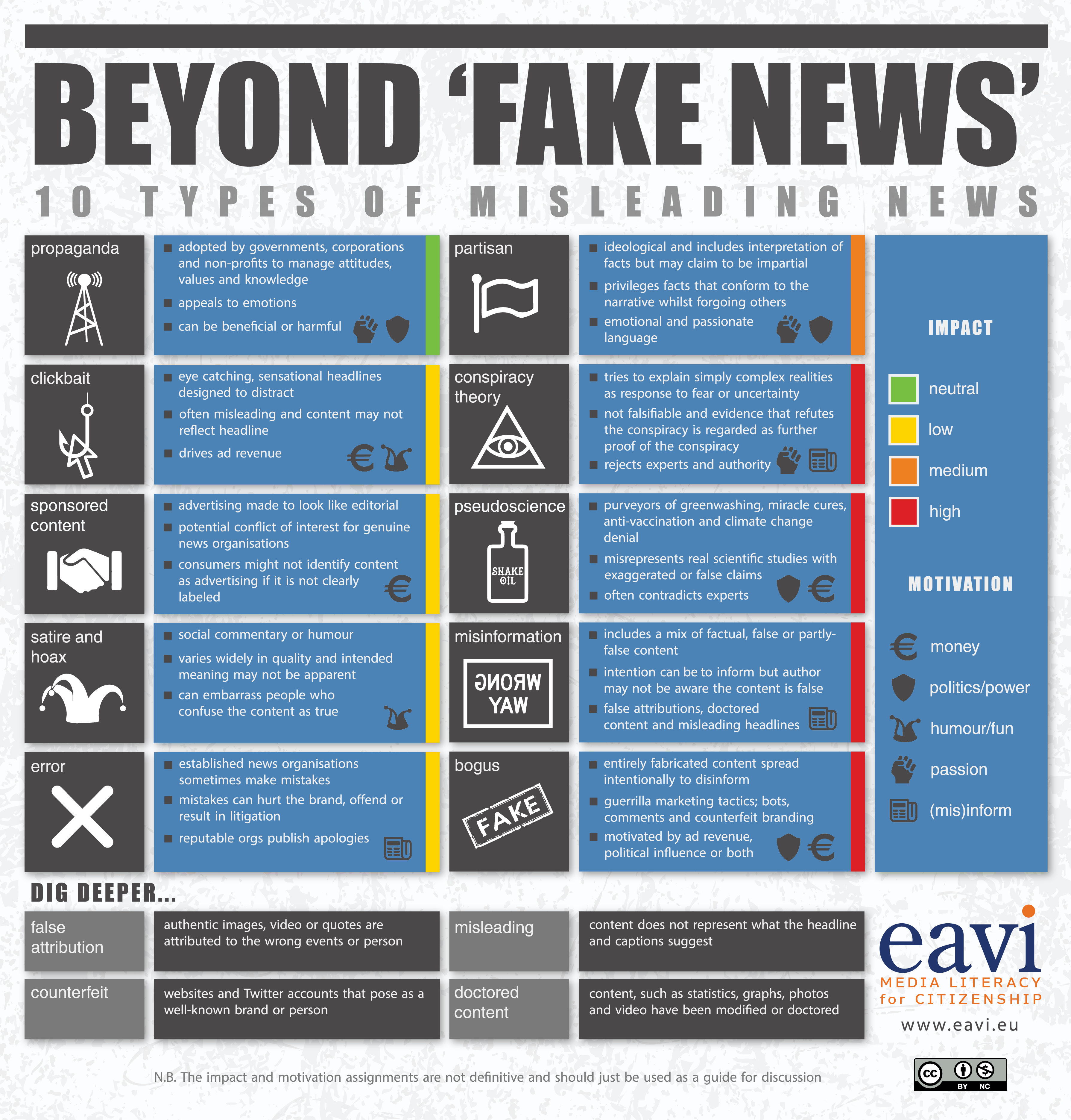
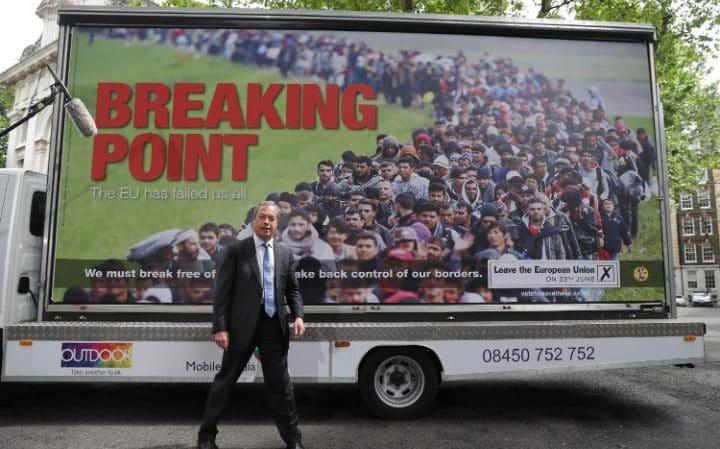
Nigel Farage of UKIP used anti-migrant propaganda in the 2016 UK Referendum
Propaganda is information that is spread to further a cause, idea or to do damage to a cause or idea. It is not objective. Propaganda, advertising and also public relations share similar traits by appealing the audience’s emotions.
It is important to remember that while the term propaganda most certainly has a negative connotation, it can also be beneficial. For some great examples of how propaganda can be beneficial or harmful, check out Mind Over Media, a crowdsourced project from the Media Education Lab at the University of Rhode Island, where users upload examples of propaganda, rate it on a level of negative or positive, interpret its message and discuss how it operates.
Examples
The Vote Leave Campaign
This map from the Brexit referendum’s Vote Leave Campaign uses fear and makes some interesting choices. It shows the countries that may potentially join the EU in the near future and plays on British fears of increased immigration. Note, however, that the only countries that are named are Iraq and Syria. This is done in order to emphasise their proximity to Turkey. Is it suggesting that if the EU accepts Turkey as a member state then Iraq and Syria will follow? The map is cropped from this larger pdf pamphlet.
Anti-Macron propaganda
Sputnik, a Russian news outlet, published many unfounded claims in different languages about Emmanuel Macron in the lead up to the French elections in 2017. Are they propaganda, fake news, partisan, conspiracy theories… or all of the above? What does Sputnik have against Macron? See here and here for the images.
Video: “Important”
This video from director, Joss Whedon (Buffy the Vampire Slayer, The Avengers) was released ahead of the US election, as part of a campaign called Save the Day, which was ostensibly about to convincing Americans to vote. The production uses a mix of celebrity testimonials and plain folks appeal techniques but also uses the anti-marketing technique. It does this by exercising self-awareness and sarcastically commenting on their own use of the testimonial technique to appeal to the audience. Naturally, there is an ad made in response, which utilised plain folks appeal.
It could be interesting for students to explore the techniques the ad uses, whether they consider it propaganda, and discuss what the ‘real’ message is. Are they just trying to get people to vote?
Equal Pay day 2017
This ad was part of Equal Pay Day’s 2017 campaign in Belgium. Equal Pay Day is concerned with the pay gap between men and women and the campaign suggests that women have to start working 10 years sooner in order to earn as much as men in their lifetimes. Watch it here in English with subtitles in most European languages. Watch the 2016 campaign video here.
Is it beneficial or harmful?
Clickbait’s main purpose is to pique peoples’ interest enough to click through to the content as a method of increasing ad revenue. Once the reader is there, the content rarely satisfies their interest. It is considered by some to be a modern day equivalent of Yellow Journalism.
Clickbait sites like Buzzfeed and Upworthy are everywhere, and ironically, even the title of this article and our infographic could be considered clickbait. But to find examples, check Zimdars Fake News List on Wikipedia which lists a number of clickbait sites alongside fake news and satire sites. For examples of satirical clickbait, check out Clickhole.
This 2016 study, from Stanford University, Evaluating Information: The Cornerstone of Civic Online Reasoning found that 80% of middle school students involved in the study identified sponsored content (also known as native advertising) as real news. The practice has caused a stir in the media industry because it seemingly breaks the long-held divide between editorial and advertorial content.
One of the most infamous examples of sponsored content is an article from The Atlantic in 2013, titled David Miscavige Leads Scientology to Milestone Year. The article resulted in a lot of backlash and discussion of the merits and ethical concerns around sponsored content. Of course, it has since been taken down but we have a pdf copy here.
Some more examples
- This article in the New York Times, Women Inmates: Why the Male Model Doesn’t Work, is actually a sponsored ad for the Netflix series Orange is The New Black.
- This #LikeAGirl video has clocked up 64 million views on YouTube and is part of a campaign to encourage confidence in young women. The campaign, however, is sponsored by Tampax. Many praised the video and campaign for its empowering message whilst also criticising it for being deceptive.
- The viral First Kiss video featured 20 strangers kissing for the first time. It took some time before people began to learn that the video was an ad for a clothing company and that the kissing strangers were actually actors.
There are many satire websites on the web. Perhaps the most well-known of these is The Onion but there are many in Europe, some of which are listed below. Of course, the real trick with satire is that there are many lesser-known sites that catch people out as well as sites that claim to be satire but are not necessarily very funny.
Big Ben to be renamed Massive Mohammed from 2018
An example of a satire story catching people off-guard is an article from The Rochdale Herald which stated that London’s Big Ben clock would be renamed, Massive Mohammed. As reported by Buzzfeed, many people, apparently unaware of the satirical nature of The Rochdale Herald, were outraged at what they felt was an assault on British cultural heritage.
- The Daily Mash – UK
- News Biscuit – UK
- Private Eye – UK
- Titanic Magazine – Germany
- Charlie Hebdo – France
- Le Canard enchaîné – France
- Aszdziennik – Poland
- Academia Cațavencu – Hungary
- Il Vernacoliere – Italy
- To Vatraxi – Greece
- The Phoenix – Ireland
- Der Postillon – Germany
- Nebelspalter – Switzerland
- El Jueves – Spain
- Eulenspiegel – Germany
- Zaytung – Turkey
- Nordrpesse – Belgium
- El Mundo Today – Spain
- De Speld – Netherlands
There are some great lists of error corrections on the web.
Poynter publishes a list each year. Here is 2016, 2014, 2013.
Buzzfeed has a list which, incidentally, has quite a clickbait-y headline, 24 Spectacular Newspaper Corrections.
An article by Craig Silverman at Buzzfeed News traced a group of hyper-partisan liberal and conservative websites back to the same company by identifying their Google Analytics and AdSense IDs. On occasion, the websites publish the same stories with only a few word changes to prompt outrage from either side.
Two such articles concern Kellyanne Conway, a Counselor to the President in the Trump administration. The titles are as follows, with links to archived copies of the articles;
- White House Just Gave Conway The Boot, Prepare To Be Infuriated [from Conservative 101]
- NEWS White House FINALLY Gives Kellyanne Conway The Boot, Are You Glad? [from Liberal Society]
We also found two more articles from these sites which could be used for comparison in a lesson. They concern an ad for The New York Times that ran during tthe 2017 Academy Awards broadcast;
- The New York Times Takes Shot At Trump In Epic Academy Awards Ad, Trump Is Furious [from Liberal Society]
- The New York Times Just Ran This Petty Ad At The Oscars, What A Joke! [from Conservative 101]
It could be interesting to have students compare the language of the articles before explaining to them that both sites are owned by the same company.

We have listed conspiracy theories as separate to fake news mainly because conspiracy theories tend to have a shelf life beyond being debunked. Conspiracy theories can also spawn further sub-theories which rely upon the original theory being true and have even been the topic of some big-budget documentaries. There are of course examples of conspiracy theories which turned out to be true or part-true but these are exceptions that prove the rule.
One of the difficulties of dealing with conspiracies is that the adherents appear to be practising a scepticism of mainstream media accounts, which is something as media and information literacy educators we tend to encourage. This is perhaps why it is helpful to focus on their non-falsifiability.
For example;
A nice example to use with students is this article which combines a number of our ‘Ten types of Misleading News’ categories. Archived here, the article, from a counterfeit website called CNN.com.de claims: “Donald Trump Says the Earth is flat.” Note that there is no disclaimer on the site suggesting their content is satire. Belief in the veracity of the story obviously grew in popularity such that the fact-checking website Snopes felt the need to debunk it.
Have students read the article and discuss whether they think it is true, satire, hoax, bogus, partisan or conspiracy theory. It may be an interesting entry into further exploring the proliferation of flat earth conspiracy theories.
An ironic article in the Huffington Post titled “The Earth Is Flat… but They Can’t Handle the Truth” could also spark some interesting conversations about the validity of ridiculing the arguments of your opponents.
The Eclipse Conspiracy
This satirical article from The Atlantic uses many of the same arguments found in conspiracy theories;
- why isn’t the media talking about this? ✓
- promoting the eclipse is just a way for some rich person to sell special glasses ✓
- Google is covering up results that say the eclipse is fake ✓
- NASA is lying to us ✓
Have students read the article and discuss whether they think it is serious or satire.
For more on how to deal with conspiracy theories, see this article from the Oxford Education blog. [Conspiracy theories, intuitions and critical thinking: Part 1]
To find content in French, check out Conspiracy Watch.
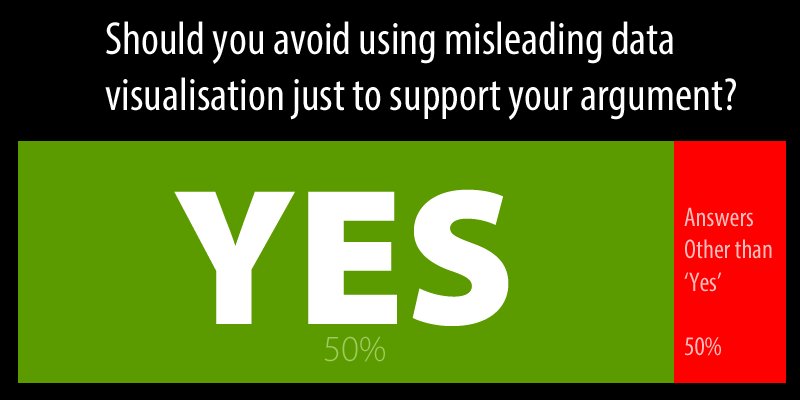
Pseudoscience shares much in common with conspiracy theories, however, it often the ‘science’ used to back up the theory rather than the theory itself. Topics that relate to both conspiracy theory and pseudoscience concern the anti-vaccination movement, climate change denial, chemtrails, flat earther theories, intelligent design and much more.
Alternative health websites
Other pseudoscience topics are reflected in the multibillion dollar alternative health care industry. Even some of the more reputable publications have been guilty of this. Wikipedia maintains a list of pseudoscience topics here.
Misrepresented studies
Often, pseudoscience is proliferated by a misreading of actual scientific studies and a misrepresentation of data in order to make the studies’ findings seem more ‘newsworthy’. Check out our article, “Lies, damned Lies and Statistics” for some examples and resources for teaching students to read graphs, data and statistics.
Some popular websites that have been accused of propagating pseudoscience, include;
- Natural News
- David ‘Avocado’ Wolfe
- The Mind Unleashed
However, there really is no shortage of quackery out there.
This useful video below from Above The Noise gives us 4 tips to spot bad science news, using an acronym, GLAD;
G – Get past the clickbait
L – Look past the crazy claims
A – Analyse sources
D – Determine outside expert opinion
Examples of misinformation can really be found in any of the 10 Types of Misleading News categories. We see misinformation as being different to disinformation in its intent.
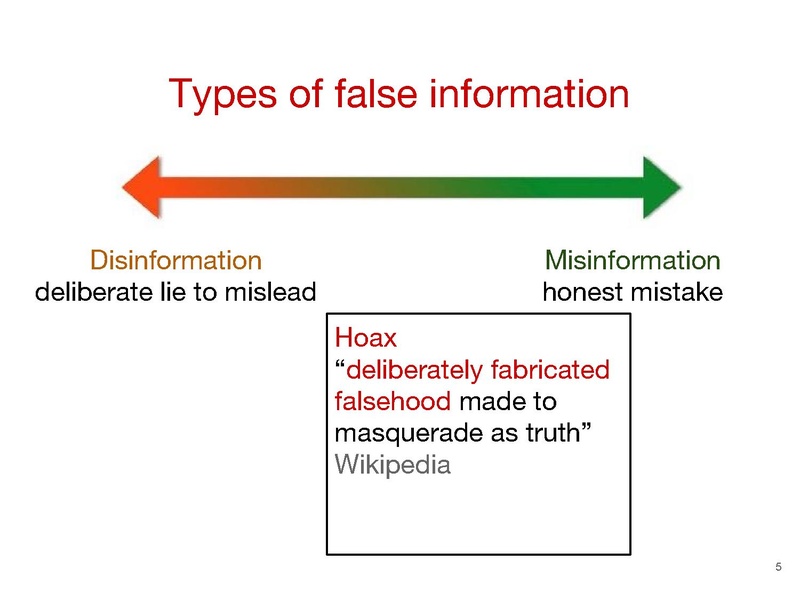
By Srijankedia – File was at: File:Wikipedia Hoax Detection – WMF Nov 18 – slides.pdf. Screenshot in particular is free-use-license as own work by author Srijankedia. More source information at Wikimedia Research (18 November 2015) and Research:Understanding hoax articles on English Wikipedia. YouTube video at Wikimedia Research Showcase – November 2015., CC BY-SA 4.0, https://commons.wikimedia.org/w/index.php?curid=53932002
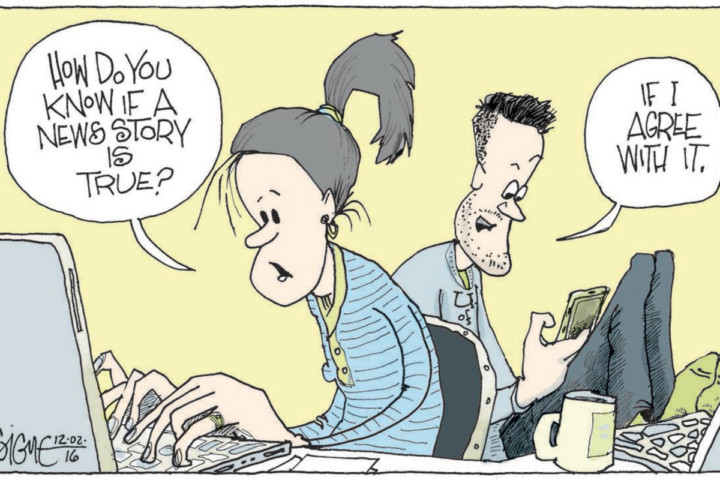
Source: http://www.philly.com/philly/business/Google-Facebook-and-Pew-are-going-after-cyber-con-jobs-and-fake-news-.html
As stated in the graphic, bogus news is news that is completely fabricated. Listed below are a few sources for finding examples of bogus news websites, however, be aware that many of these sites are quite ephemeral by nature, popping up here and there from time to time and then disappearing.
- This list from assistant professor of communications at Merrimack College, Melissa Zimdars. Zimdars made the list as a resource for her students who she found were regularly using questionable sources in their research. When first released it caused quite some controversy but has since been updated. It includes false, misleading, clickbait-y, and satirical “news” sources. [Zimdars’ fake news list]
The work needed to effectively filter information in our media-saturated environment takes time and skill. A study showed that the more content we consume, the more our ability to make decisions about its veracity becomes impaired. With 80% of Europeans now regularly going online, it is vital for the sustainable and effective functioning of democracy for citizens to be able to curate their media diets with a healthy critical eye.
Our Beyond Fake News infographic identifies the 10 types of potentially misleading news. It was created to be used in class with real-world examples to spark classroom debate and reflection on the ways that media is constructed.
We hesitated to put the term ‘fake news’ in the title of the infographic as, ironically, the term itself is a misleading simplification. Apart from the fact that the term has been co-opted to attack and silence mainstream media, the suggestion that there are simply two types of news; real and fake, doesn’t leave much room for nuance.
Below this article, you will find a pdf version of the infographic as well as a dropdown list containing some resources for teaching the 10 Types of Misleading News.
The 10 types
Of course, neither of the 10 types can be seen in isolation to the others. Partisan news outlets may also be identified as propaganda. And propaganda can be found in a sponsored post. Pseudoscience and conspiracy theories certainly enjoy each others company, see: anti-vaccination movement and climate change denialism. Likewise, completely bogus content may entice its audience with a clickbait headline. Finding examples and identifying which categories they fit into is all part of the fun of using this graphic.
The motivations
The motivations behind certain kinds of content can be many and varied. Money or power are almost always present however, there may be other motivations at play. A pseudoscientific column about climate change may be motivated by a certain ideological or political cause. However, another form of pseudoscience, health news, which some have identified as being among the most prolific in the ‘fake news’ typology, might be motivated by money or share similarities with clickbait characteristics; “The Secret Diet Your Doctor Won’t Tell You About” is a familiar refrain.
Impact levels
The impact levels are not definitive either. For instance, some students may feel that conspiracy theories are just a bit of fun, while some of us reflect that the propagation of one recent conspiracy theory led to an actual incident of violence; Pizzagate.
We hope our infographic will prompt healthy discussion. When used in conjunction with the Center for Media Literacy’s 5 media literacy concepts and questions, we believe it is a powerful way for people of any age to provoke a line of media inquiry that becomes second nature.
Some help, please!
We will endeavour to find resources with which to use and compare with the infographic but we would love it you would suggest your own to us. Especially in languages other than English.
Check out the EAVI Individual Members Group on Facebook and join so you can post examples there.
We would also love to hear your testimonials. Let us know of any successes you have had when using it, or if you think of any ways the graphic can be improved.
Translations
If you are able to translate the infographic into your mother tongue then you are an awesome person! We will credit you, of course. Contact us at [email protected] or reach out to us via our social media channels for more details.
With thanks…
We must also thank EAVI’s individual members for their feedback as well as Katerina Chryssanthopoulou of the newly-formed Media Literacy Institute in Greece for her input and ideas while creating the graphic.
[click the image below for the pdf version]


Nigel Farage of UKIP used anti-migrant propaganda in the 2016 UK Referendum
Propaganda is information that is spread to further a cause, idea or to do damage to a cause or idea. It is not objective. Propaganda, advertising and also public relations share similar traits by appealing the audience’s emotions.
It is important to remember that while the term propaganda most certainly has a negative connotation, it can also be beneficial. For some great examples of how propaganda can be beneficial or harmful, check out Mind Over Media, a crowdsourced project from the Media Education Lab at the University of Rhode Island, where users upload examples of propaganda, rate it on a level of negative or positive, interpret its message and discuss how it operates.
Examples
The Vote Leave Campaign
This map from the Brexit referendum’s Vote Leave Campaign uses fear and makes some interesting choices. It shows the countries that may potentially join the EU in the near future and plays on British fears of increased immigration. Note, however, that the only countries that are named are Iraq and Syria. This is done in order to emphasise their proximity to Turkey. Is it suggesting that if the EU accepts Turkey as a member state then Iraq and Syria will follow? The map is cropped from this larger pdf pamphlet.
Anti-Macron propaganda
Sputnik, a Russian news outlet, published many unfounded claims in different languages about Emmanuel Macron in the lead up to the French elections in 2017. Are they propaganda, fake news, partisan, conspiracy theories… or all of the above? What does Sputnik have against Macron? See here and here for the images.
Video: “Important”
This video from director, Joss Whedon (Buffy the Vampire Slayer, The Avengers) was released ahead of the US election, as part of a campaign called Save the Day, which was ostensibly about to convincing Americans to vote. The production uses a mix of celebrity testimonials and plain folks appeal techniques but also uses the anti-marketing technique. It does this by exercising self-awareness and sarcastically commenting on their own use of the testimonial technique to appeal to the audience. Naturally, there is an ad made in response, which utilised plain folks appeal.
It could be interesting for students to explore the techniques the ad uses, whether they consider it propaganda, and discuss what the ‘real’ message is. Are they just trying to get people to vote?
Equal Pay day 2017
This ad was part of Equal Pay Day’s 2017 campaign in Belgium. Equal Pay Day is concerned with the pay gap between men and women and the campaign suggests that women have to start working 10 years sooner in order to earn as much as men in their lifetimes. Watch it here in English with subtitles in most European languages. Watch the 2016 campaign video here.
Is it beneficial or harmful?
Clickbait’s main purpose is to pique peoples’ interest enough to click through to the content as a method of increasing ad revenue. Once the reader is there, the content rarely satisfies their interest. It is considered by some to be a modern day equivalent of Yellow Journalism.
Clickbait sites like Buzzfeed and Upworthy are everywhere, and ironically, even the title of this article and our infographic could be considered clickbait. But to find examples, check Zimdars Fake News List on Wikipedia which lists a number of clickbait sites alongside fake news and satire sites. For examples of satirical clickbait, check out Clickhole.
This 2016 study, from Stanford University, Evaluating Information: The Cornerstone of Civic Online Reasoning found that 80% of middle school students involved in the study identified sponsored content (also known as native advertising) as real news. The practice has caused a stir in the media industry because it seemingly breaks the long-held divide between editorial and advertorial content.
One of the most infamous examples of sponsored content is an article from The Atlantic in 2013, titled David Miscavige Leads Scientology to Milestone Year. The article resulted in a lot of backlash and discussion of the merits and ethical concerns around sponsored content. Of course, it has since been taken down but we have a pdf copy here.
Some more examples
- This article in the New York Times, Women Inmates: Why the Male Model Doesn’t Work, is actually a sponsored ad for the Netflix series Orange is The New Black.
- This #LikeAGirl video has clocked up 64 million views on YouTube and is part of a campaign to encourage confidence in young women. The campaign, however, is sponsored by Tampax. Many praised the video and campaign for its empowering message whilst also criticising it for being deceptive.
- The viral First Kiss video featured 20 strangers kissing for the first time. It took some time before people began to learn that the video was an ad for a clothing company and that the kissing strangers were actually actors.
There are many satire websites on the web. Perhaps the most well-known of these is The Onion but there are many in Europe, some of which are listed below. Of course, the real trick with satire is that there are many lesser-known sites that catch people out as well as sites that claim to be satire but are not necessarily very funny.
Big Ben to be renamed Massive Mohammed from 2018
An example of a satire story catching people off-guard is an article from The Rochdale Herald which stated that London’s Big Ben clock would be renamed, Massive Mohammed. As reported by Buzzfeed, many people, apparently unaware of the satirical nature of The Rochdale Herald, were outraged at what they felt was an assault on British cultural heritage.
- The Daily Mash – UK
- News Biscuit – UK
- Private Eye – UK
- Titanic Magazine – Germany
- Charlie Hebdo – France
- Le Canard enchaîné – France
- Aszdziennik – Poland
- Academia Cațavencu – Hungary
- Il Vernacoliere – Italy
- To Vatraxi – Greece
- The Phoenix – Ireland
- Der Postillon – Germany
- Nebelspalter – Switzerland
- El Jueves – Spain
- Eulenspiegel – Germany
- Zaytung – Turkey
- Nordrpesse – Belgium
- El Mundo Today – Spain
- De Speld – Netherlands
There are some great lists of error corrections on the web.
Poynter publishes a list each year. Here is 2016, 2014, 2013.
Buzzfeed has a list which, incidentally, has quite a clickbait-y headline, 24 Spectacular Newspaper Corrections.
An article by Craig Silverman at Buzzfeed News traced a group of hyper-partisan liberal and conservative websites back to the same company by identifying their Google Analytics and AdSense IDs. On occasion, the websites publish the same stories with only a few word changes to prompt outrage from either side.
Two such articles concern Kellyanne Conway, a Counselor to the President in the Trump administration. The titles are as follows, with links to archived copies of the articles;
- White House Just Gave Conway The Boot, Prepare To Be Infuriated [from Conservative 101]
- NEWS White House FINALLY Gives Kellyanne Conway The Boot, Are You Glad? [from Liberal Society]
We also found two more articles from these sites which could be used for comparison in a lesson. They concern an ad for The New York Times that ran during tthe 2017 Academy Awards broadcast;
- The New York Times Takes Shot At Trump In Epic Academy Awards Ad, Trump Is Furious [from Liberal Society]
- The New York Times Just Ran This Petty Ad At The Oscars, What A Joke! [from Conservative 101]
It could be interesting to have students compare the language of the articles before explaining to them that both sites are owned by the same company.

We have listed conspiracy theories as separate to fake news mainly because conspiracy theories tend to have a shelf life beyond being debunked. Conspiracy theories can also spawn further sub-theories which rely upon the original theory being true and have even been the topic of some big-budget documentaries. There are of course examples of conspiracy theories which turned out to be true or part-true but these are exceptions that prove the rule.
One of the difficulties of dealing with conspiracies is that the adherents appear to be practising a scepticism of mainstream media accounts, which is something as media and information literacy educators we tend to encourage. This is perhaps why it is helpful to focus on their non-falsifiability.
For example;
A nice example to use with students is this article which combines a number of our ‘Ten types of Misleading News’ categories. Archived here, the article, from a counterfeit website called CNN.com.de claims: “Donald Trump Says the Earth is flat.” Note that there is no disclaimer on the site suggesting their content is satire. Belief in the veracity of the story obviously grew in popularity such that the fact-checking website Snopes felt the need to debunk it.
Have students read the article and discuss whether they think it is true, satire, hoax, bogus, partisan or conspiracy theory. It may be an interesting entry into further exploring the proliferation of flat earth conspiracy theories.
An ironic article in the Huffington Post titled “The Earth Is Flat… but They Can’t Handle the Truth” could also spark some interesting conversations about the validity of ridiculing the arguments of your opponents.
The Eclipse Conspiracy
This satirical article from The Atlantic uses many of the same arguments found in conspiracy theories;
- why isn’t the media talking about this? ✓
- promoting the eclipse is just a way for some rich person to sell special glasses ✓
- Google is covering up results that say the eclipse is fake ✓
- NASA is lying to us ✓
Have students read the article and discuss whether they think it is serious or satire.
For more on how to deal with conspiracy theories, see this article from the Oxford Education blog. [Conspiracy theories, intuitions and critical thinking: Part 1]
To find content in French, check out Conspiracy Watch.

Pseudoscience shares much in common with conspiracy theories, however, it often the ‘science’ used to back up the theory rather than the theory itself. Topics that relate to both conspiracy theory and pseudoscience concern the anti-vaccination movement, climate change denial, chemtrails, flat earther theories, intelligent design and much more.
Alternative health websites
Other pseudoscience topics are reflected in the multibillion dollar alternative health care industry. Even some of the more reputable publications have been guilty of this. Wikipedia maintains a list of pseudoscience topics here.
Misrepresented studies
Often, pseudoscience is proliferated by a misreading of actual scientific studies and a misrepresentation of data in order to make the studies’ findings seem more ‘newsworthy’. Check out our article, “Lies, damned Lies and Statistics” for some examples and resources for teaching students to read graphs, data and statistics.
Some popular websites that have been accused of propagating pseudoscience, include;
- Natural News
- David ‘Avocado’ Wolfe
- The Mind Unleashed
However, there really is no shortage of quackery out there.
This useful video below from Above The Noise gives us 4 tips to spot bad science news, using an acronym, GLAD;
G – Get past the clickbait
L – Look past the crazy claims
A – Analyse sources
D – Determine outside expert opinion
Examples of misinformation can really be found in any of the 10 Types of Misleading News categories. We see misinformation as being different to disinformation in its intent.

By Srijankedia – File was at: File:Wikipedia Hoax Detection – WMF Nov 18 – slides.pdf. Screenshot in particular is free-use-license as own work by author Srijankedia. More source information at Wikimedia Research (18 November 2015) and Research:Understanding hoax articles on English Wikipedia. YouTube video at Wikimedia Research Showcase – November 2015., CC BY-SA 4.0, https://commons.wikimedia.org/w/index.php?curid=53932002

Source: http://www.philly.com/philly/business/Google-Facebook-and-Pew-are-going-after-cyber-con-jobs-and-fake-news-.html
As stated in the graphic, bogus news is news that is completely fabricated. Listed below are a few sources for finding examples of bogus news websites, however, be aware that many of these sites are quite ephemeral by nature, popping up here and there from time to time and then disappearing.
- This list from assistant professor of communications at Merrimack College, Melissa Zimdars. Zimdars made the list as a resource for her students who she found were regularly using questionable sources in their research. When first released it caused quite some controversy but has since been updated. It includes false, misleading, clickbait-y, and satirical “news” sources. [Zimdars’ fake news list]
The work needed to effectively filter information in our media-saturated environment takes time and skill. A study showed that the more content we consume, the more our ability to make decisions about its veracity becomes impaired. With 80% of Europeans now regularly going online, it is vital for the sustainable and effective functioning of democracy for citizens to be able to curate their media diets with a healthy critical eye.
Our Beyond Fake News infographic identifies the 10 types of potentially misleading news. It was created to be used in class with real-world examples to spark classroom debate and reflection on the ways that media is constructed.
We hesitated to put the term ‘fake news’ in the title of the infographic as, ironically, the term itself is a misleading simplification. Apart from the fact that the term has been co-opted to attack and silence mainstream media, the suggestion that there are simply two types of news; real and fake, doesn’t leave much room for nuance.
Below this article, you will find a pdf version of the infographic as well as a dropdown list containing some resources for teaching the 10 Types of Misleading News.
The 10 types
Of course, neither of the 10 types can be seen in isolation to the others. Partisan news outlets may also be identified as propaganda. And propaganda can be found in a sponsored post. Pseudoscience and conspiracy theories certainly enjoy each others company, see: anti-vaccination movement and climate change denialism. Likewise, completely bogus content may entice its audience with a clickbait headline. Finding examples and identifying which categories they fit into is all part of the fun of using this graphic.
The motivations
The motivations behind certain kinds of content can be many and varied. Money or power are almost always present however, there may be other motivations at play. A pseudoscientific column about climate change may be motivated by a certain ideological or political cause. However, another form of pseudoscience, health news, which some have identified as being among the most prolific in the ‘fake news’ typology, might be motivated by money or share similarities with clickbait characteristics; “The Secret Diet Your Doctor Won’t Tell You About” is a familiar refrain.
Impact levels
The impact levels are not definitive either. For instance, some students may feel that conspiracy theories are just a bit of fun, while some of us reflect that the propagation of one recent conspiracy theory led to an actual incident of violence; Pizzagate.
We hope our infographic will prompt healthy discussion. When used in conjunction with the Center for Media Literacy’s 5 media literacy concepts and questions, we believe it is a powerful way for people of any age to provoke a line of media inquiry that becomes second nature.
Some help, please!
We will endeavour to find resources with which to use and compare with the infographic but we would love it you would suggest your own to us. Especially in languages other than English.
Check out the EAVI Individual Members Group on Facebook and join so you can post examples there.
We would also love to hear your testimonials. Let us know of any successes you have had when using it, or if you think of any ways the graphic can be improved.
Translations
If you are able to translate the infographic into your mother tongue then you are an awesome person! We will credit you, of course. Contact us at [email protected] or reach out to us via our social media channels for more details.
With thanks…
We must also thank EAVI’s individual members for their feedback as well as Katerina Chryssanthopoulou of the newly-formed Media Literacy Institute in Greece for her input and ideas while creating the graphic.
[click the image below for the pdf version]


Nigel Farage of UKIP used anti-migrant propaganda in the 2016 UK Referendum
Propaganda is information that is spread to further a cause, idea or to do damage to a cause or idea. It is not objective. Propaganda, advertising and also public relations share similar traits by appealing the audience’s emotions.
It is important to remember that while the term propaganda most certainly has a negative connotation, it can also be beneficial. For some great examples of how propaganda can be beneficial or harmful, check out Mind Over Media, a crowdsourced project from the Media Education Lab at the University of Rhode Island, where users upload examples of propaganda, rate it on a level of negative or positive, interpret its message and discuss how it operates.
Examples
The Vote Leave Campaign
This map from the Brexit referendum’s Vote Leave Campaign uses fear and makes some interesting choices. It shows the countries that may potentially join the EU in the near future and plays on British fears of increased immigration. Note, however, that the only countries that are named are Iraq and Syria. This is done in order to emphasise their proximity to Turkey. Is it suggesting that if the EU accepts Turkey as a member state then Iraq and Syria will follow? The map is cropped from this larger pdf pamphlet.
Anti-Macron propaganda
Sputnik, a Russian news outlet, published many unfounded claims in different languages about Emmanuel Macron in the lead up to the French elections in 2017. Are they propaganda, fake news, partisan, conspiracy theories… or all of the above? What does Sputnik have against Macron? See here and here for the images.
Video: “Important”
This video from director, Joss Whedon (Buffy the Vampire Slayer, The Avengers) was released ahead of the US election, as part of a campaign called Save the Day, which was ostensibly about to convincing Americans to vote. The production uses a mix of celebrity testimonials and plain folks appeal techniques but also uses the anti-marketing technique. It does this by exercising self-awareness and sarcastically commenting on their own use of the testimonial technique to appeal to the audience. Naturally, there is an ad made in response, which utilised plain folks appeal.
It could be interesting for students to explore the techniques the ad uses, whether they consider it propaganda, and discuss what the ‘real’ message is. Are they just trying to get people to vote?
Equal Pay day 2017
This ad was part of Equal Pay Day’s 2017 campaign in Belgium. Equal Pay Day is concerned with the pay gap between men and women and the campaign suggests that women have to start working 10 years sooner in order to earn as much as men in their lifetimes. Watch it here in English with subtitles in most European languages. Watch the 2016 campaign video here.
Is it beneficial or harmful?
Clickbait’s main purpose is to pique peoples’ interest enough to click through to the content as a method of increasing ad revenue. Once the reader is there, the content rarely satisfies their interest. It is considered by some to be a modern day equivalent of Yellow Journalism.
Clickbait sites like Buzzfeed and Upworthy are everywhere, and ironically, even the title of this article and our infographic could be considered clickbait. But to find examples, check Zimdars Fake News List on Wikipedia which lists a number of clickbait sites alongside fake news and satire sites. For examples of satirical clickbait, check out Clickhole.
This 2016 study, from Stanford University, Evaluating Information: The Cornerstone of Civic Online Reasoning found that 80% of middle school students involved in the study identified sponsored content (also known as native advertising) as real news. The practice has caused a stir in the media industry because it seemingly breaks the long-held divide between editorial and advertorial content.
One of the most infamous examples of sponsored content is an article from The Atlantic in 2013, titled David Miscavige Leads Scientology to Milestone Year. The article resulted in a lot of backlash and discussion of the merits and ethical concerns around sponsored content. Of course, it has since been taken down but we have a pdf copy here.
Some more examples
- This article in the New York Times, Women Inmates: Why the Male Model Doesn’t Work, is actually a sponsored ad for the Netflix series Orange is The New Black.
- This #LikeAGirl video has clocked up 64 million views on YouTube and is part of a campaign to encourage confidence in young women. The campaign, however, is sponsored by Tampax. Many praised the video and campaign for its empowering message whilst also criticising it for being deceptive.
- The viral First Kiss video featured 20 strangers kissing for the first time. It took some time before people began to learn that the video was an ad for a clothing company and that the kissing strangers were actually actors.
There are many satire websites on the web. Perhaps the most well-known of these is The Onion but there are many in Europe, some of which are listed below. Of course, the real trick with satire is that there are many lesser-known sites that catch people out as well as sites that claim to be satire but are not necessarily very funny.
Big Ben to be renamed Massive Mohammed from 2018
An example of a satire story catching people off-guard is an article from The Rochdale Herald which stated that London’s Big Ben clock would be renamed, Massive Mohammed. As reported by Buzzfeed, many people, apparently unaware of the satirical nature of The Rochdale Herald, were outraged at what they felt was an assault on British cultural heritage.
- The Daily Mash – UK
- News Biscuit – UK
- Private Eye – UK
- Titanic Magazine – Germany
- Charlie Hebdo – France
- Le Canard enchaîné – France
- Aszdziennik – Poland
- Academia Cațavencu – Hungary
- Il Vernacoliere – Italy
- To Vatraxi – Greece
- The Phoenix – Ireland
- Der Postillon – Germany
- Nebelspalter – Switzerland
- El Jueves – Spain
- Eulenspiegel – Germany
- Zaytung – Turkey
- Nordrpesse – Belgium
- El Mundo Today – Spain
- De Speld – Netherlands
There are some great lists of error corrections on the web.
Poynter publishes a list each year. Here is 2016, 2014, 2013.
Buzzfeed has a list which, incidentally, has quite a clickbait-y headline, 24 Spectacular Newspaper Corrections.
An article by Craig Silverman at Buzzfeed News traced a group of hyper-partisan liberal and conservative websites back to the same company by identifying their Google Analytics and AdSense IDs. On occasion, the websites publish the same stories with only a few word changes to prompt outrage from either side.
Two such articles concern Kellyanne Conway, a Counselor to the President in the Trump administration. The titles are as follows, with links to archived copies of the articles;
- White House Just Gave Conway The Boot, Prepare To Be Infuriated [from Conservative 101]
- NEWS White House FINALLY Gives Kellyanne Conway The Boot, Are You Glad? [from Liberal Society]
We also found two more articles from these sites which could be used for comparison in a lesson. They concern an ad for The New York Times that ran during tthe 2017 Academy Awards broadcast;
- The New York Times Takes Shot At Trump In Epic Academy Awards Ad, Trump Is Furious [from Liberal Society]
- The New York Times Just Ran This Petty Ad At The Oscars, What A Joke! [from Conservative 101]
It could be interesting to have students compare the language of the articles before explaining to them that both sites are owned by the same company.

We have listed conspiracy theories as separate to fake news mainly because conspiracy theories tend to have a shelf life beyond being debunked. Conspiracy theories can also spawn further sub-theories which rely upon the original theory being true and have even been the topic of some big-budget documentaries. There are of course examples of conspiracy theories which turned out to be true or part-true but these are exceptions that prove the rule.
One of the difficulties of dealing with conspiracies is that the adherents appear to be practising a scepticism of mainstream media accounts, which is something as media and information literacy educators we tend to encourage. This is perhaps why it is helpful to focus on their non-falsifiability.
For example;
A nice example to use with students is this article which combines a number of our ‘Ten types of Misleading News’ categories. Archived here, the article, from a counterfeit website called CNN.com.de claims: “Donald Trump Says the Earth is flat.” Note that there is no disclaimer on the site suggesting their content is satire. Belief in the veracity of the story obviously grew in popularity such that the fact-checking website Snopes felt the need to debunk it.
Have students read the article and discuss whether they think it is true, satire, hoax, bogus, partisan or conspiracy theory. It may be an interesting entry into further exploring the proliferation of flat earth conspiracy theories.
An ironic article in the Huffington Post titled “The Earth Is Flat… but They Can’t Handle the Truth” could also spark some interesting conversations about the validity of ridiculing the arguments of your opponents.
The Eclipse Conspiracy
This satirical article from The Atlantic uses many of the same arguments found in conspiracy theories;
- why isn’t the media talking about this? ✓
- promoting the eclipse is just a way for some rich person to sell special glasses ✓
- Google is covering up results that say the eclipse is fake ✓
- NASA is lying to us ✓
Have students read the article and discuss whether they think it is serious or satire.
For more on how to deal with conspiracy theories, see this article from the Oxford Education blog. [Conspiracy theories, intuitions and critical thinking: Part 1]
To find content in French, check out Conspiracy Watch.

Pseudoscience shares much in common with conspiracy theories, however, it often the ‘science’ used to back up the theory rather than the theory itself. Topics that relate to both conspiracy theory and pseudoscience concern the anti-vaccination movement, climate change denial, chemtrails, flat earther theories, intelligent design and much more.
Alternative health websites
Other pseudoscience topics are reflected in the multibillion dollar alternative health care industry. Even some of the more reputable publications have been guilty of this. Wikipedia maintains a list of pseudoscience topics here.
Misrepresented studies
Often, pseudoscience is proliferated by a misreading of actual scientific studies and a misrepresentation of data in order to make the studies’ findings seem more ‘newsworthy’. Check out our article, “Lies, damned Lies and Statistics” for some examples and resources for teaching students to read graphs, data and statistics.
Some popular websites that have been accused of propagating pseudoscience, include;
- Natural News
- David ‘Avocado’ Wolfe
- The Mind Unleashed
However, there really is no shortage of quackery out there.
This useful video below from Above The Noise gives us 4 tips to spot bad science news, using an acronym, GLAD;
G – Get past the clickbait
L – Look past the crazy claims
A – Analyse sources
D – Determine outside expert opinion
Examples of misinformation can really be found in any of the 10 Types of Misleading News categories. We see misinformation as being different to disinformation in its intent.

By Srijankedia – File was at: File:Wikipedia Hoax Detection – WMF Nov 18 – slides.pdf. Screenshot in particular is free-use-license as own work by author Srijankedia. More source information at Wikimedia Research (18 November 2015) and Research:Understanding hoax articles on English Wikipedia. YouTube video at Wikimedia Research Showcase – November 2015., CC BY-SA 4.0, https://commons.wikimedia.org/w/index.php?curid=53932002

Source: http://www.philly.com/philly/business/Google-Facebook-and-Pew-are-going-after-cyber-con-jobs-and-fake-news-.html
As stated in the graphic, bogus news is news that is completely fabricated. Listed below are a few sources for finding examples of bogus news websites, however, be aware that many of these sites are quite ephemeral by nature, popping up here and there from time to time and then disappearing.
- This list from assistant professor of communications at Merrimack College, Melissa Zimdars. Zimdars made the list as a resource for her students who she found were regularly using questionable sources in their research. When first released it caused quite some controversy but has since been updated. It includes false, misleading, clickbait-y, and satirical “news” sources. [Zimdars’ fake news list]

